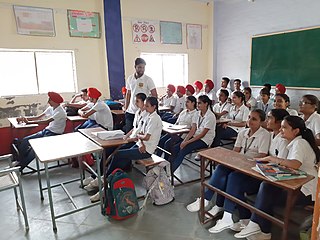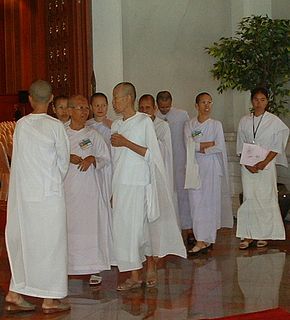Related Research Articles

A school is an educational institution designed to provide learning spaces and learning environments for the teaching of students under the direction of teachers. Most countries have systems of formal education, which is sometimes compulsory. In these systems, students progress through a series of schools. The names for these schools vary by country but generally include primary school for young children and secondary school for teenagers who have completed primary education. An institution where higher education is taught, is commonly called a university college or university.
Theravāda is the most commonly accepted name of Buddhism's oldest existing school. The school's adherents, termed Theravādins, have preserved their version of Gautama Buddha's teaching or Buddha Dhamma in the Pāli Canon for over a millennium.

Education in India is primarily managed by state-run public education system, which fall under the command of the government at three levels: central, state and local. Under various articles of the Indian Constitution and the Right of Children to Free and Compulsory Education Act, 2009, free and compulsory education is provided as a fundamental right to children aged 6 to 14. The approximate ratio of public schools to private schools in India is 7:5.

Fo Guang Shan (FGS) is an international Chinese Mahāyāna Buddhist organization and monastic order based in Taiwan that practices Humanistic Buddhism. The headquarters, Fo Guang Shan Monastery is located in Dashu District, Kaohsiung, and is the largest Buddhist monastery in Taiwan. The organization is also one of the largest charity organizations in Taiwan. The organization's counterpart for laypeople is known as the Buddha's Light International Association.
Education in Japan is managed by the Ministry of Education, Culture, Sports, Science and Technology (MEXT) of Japan. Education is compulsory at the elementary and lower secondary levels. Most students attend public schools through the lower secondary level, but private education is popular at the upper secondary and university levels. Education prior to elementary school is provided at kindergartens and day-care centres. The programmes for those children aged 3–5 resemble those at kindergartens. The educational approach at kindergartens varies greatly from unstructured environments that emphasize play to highly structured environments that are focused on having the child pass the entrance exam at a private elementary school. The academic year starts from April and ends in March, having summer vacation in August and winter vacation in the end of December to the beginning of January.
The educational system of Myanmar is operated by the government Ministry of Education. Universities and professional institutes from upper Burma and lower Burma are run by two separate entities, the Departments of Higher Education, whose office headquarters are in Yangon and Mandalay respectively. The education system is based on the United Kingdom's system, due to nearly a century of British and Christian presences in Burma. "The first Government high school was founded by the British colonial administration in 1874. Two years later, this Government High School was upgraded and became University College, Rangoon." Nearly all schools are government-operated, but recently, there has been an increase in privately funded schools. In Myanmar, schooling is compulsory until the end of elementary school, probably about 9 years old. However the international standard for schooling is 15 to 16 years old.
The history of education extends at least as far back as the first written records recovered from ancient civilizations. Historical studies have included virtually every nation.

Buddhism, specifically Theravāda Buddhism, is the State religion of Myanmar since 1961, and practiced by nearly 90% of the population. It is the most religious Buddhist country in terms of the proportion of monks in the population and proportion of income spent on religion. Adherents are most likely found among the dominant Bamar people, Shan, Rakhine, Mon, Karen, and Chinese who are well integrated into Burmese society. Monks, collectively known as the sangha (community), are venerated members of Burmese society. Among many ethnic groups in Myanmar, including the Bamar and Shan, Theravada Buddhism is practiced in conjunction with the worship of nats, which are spirits who can intercede in worldly affairs.

Maechi or Mae chee are Buddhist laywomen in Thailand who have dedicated their life to religion, vowing celibacy, living an ascetic life and taking the Eight or Ten Precepts. They occupy a position somewhere between that of an ordinary lay follower and an ordained monastic and similar to that of the sāmaṇerī.

Buddhist monasticism is one of the earliest surviving forms of organized monasticism and one of the fundamental institutions of Buddhism. Monks and nuns, called bhikkhu and bhikkhuni, are responsible for the preservation and dissemination of the Buddha's teaching and the guidance of Buddhist lay people. Three surviving traditions of monastic discipline (Vinaya), govern modern monastic life in different regional traditions: Theravada, Dharmaguptaka, and Mulasarvastivada.
The Buddhist monastic education system facilitates basic educational needs of the Asian Buddhist countries before the contemporary era. Learning traditions can be traced back to ancient India where learning began with educated monastics, teaching younger monks and the lay people. The monastic instruction was based on Buddhist value system and emphasized that learning was an end in itself, one that is "worth a strenuous pursuit to possess for its own sake" and that "teaching was for ends that were above mere gain".
Rizong gompa, Gelugpa or Yellow Hat Buddhist monastery is also called the Yuma Changchubling in Ladakh, India. It is situated at the top of a rocky side valley on the north side of the Indus, to the west of Alchi on the way to Lamayuru. It was established in 1831 by Lama Tsultim Nima under the Gelukpa order, at Ri-rdzong. There are 40 monks in the monastery. The monastery is also called "the paradise for meditation" and is noted for its extremely strict rules and standards. The nunnery, located about 2 km from the monastery, is called the "Jelichun Nunnery" or Chulichan (Chomoling), where, at present, 20 nuns reside.

Education in Cambodia is controlled by the state through the Ministry of Education in a national level and by the Department of Education at the provincial level. The Cambodian education system includes pre-school, primary, secondary education, higher education and non-formal education. The education system includes the development of sport, information technology education, research development and technical education. School enrollment has increased during the 2000s in Cambodia. USAID data shows that in 2011 primary enrollment reached 96% of the child population, lower secondary school 34% and upper secondary 21%.

Primary education or elementary education is typically the first stage of formal education, coming after preschool/kindergarten and before secondary school. Primary education takes place in primary schools, elementary schools, or first schools and middle schools, depending on the location.
The Don Bosco Foundation of Cambodia is a Non-profit organization of education founded in Cambodia in 1991 to give technical skill education to youth living in extreme poverty and to facilitate the schooling of marginalized children. The organization was a way to answer the needs of a country in its post-war period of reconstruction. DBFC is a branch of the Salesians of Don Bosco. The United Nations asked to the Salesians in Thailand to attend the children and youth of the Cambodian Refugee camps during the 1980s. DBFC answered this request by opening provisional technical schools in the camps. After the peace agreements, the organization was invited by the Cambodian government to settle in the country. The first printing press in Cambodia after the war, was provided by DBFC in the Don Bosco Technical School of Phnom Penh for the republishing, translating and writing of books and documents of education. Many schools were rebuilt in the villages and the Organization gained prestige as the first institution to provide technical education and to offer sponsorship to Cambodian children.

A kyaung is a monastery (vihara), comprising the domestic quarters and workplaces of Buddhist monks. Burmese kyaungs are sometimes also occupied by novice monks (samanera), lay attendants (kappiya), nuns, and young acolytes observing the five precepts.
Mongolia's education system has undergone colossal changes in the 20th century. The education reforms during communist times were a stark break with traditional education that was often religious and esoteric. These reforms were modeled on Soviet education systems and greatly expanded access to education for Mongolian citizens. Among the changes was a transition from the traditional Mongolian script, from 1941 to 1946, to the Cyrillic alphabet. Literacy was greatly expanded as most of the population enjoyed free primary school. However, the move to democracy and free markets in the 1990s has had some negative impacts on education in Mongolia, though these setbacks have been ameliorated some by an improving economy and policy reforms. Many adults benefit from the non-formal distance education programmes sponsored by the government in conjunction with foreign NGOs. Today education in Mongolia is overseen by the Ministry of Education, Culture, and Science.
Phaungdawoo Monastic Education Affiliated High School or Phaung Daw Oo Monastic School is a high school of Theravada Buddhist monastic education located in Aungmyethazan Township, Mandalay, Myanmar.

Basic Education High School No. 9 Mawlamyaing (Burmese: အခြေခံ ပညာ အထက်တန်း ကျောင်း အမှတ် မော်လမြိုင်; commonly known by its original name, Shin Maha Buddhaghosa National School is located on Pabedan Street, in Mawlamyaing, Mon State.
Phuktal Monastic School, also known as the Phugtal Monastic School, is set up by the Phuktal Gompa that provides the students of the local Lungnak Valley in south-eastern Zanskar, in the autonomous Himalayan region of Ladakh, in Northern India.
References
- ↑ J.R. Andrus in Burmese Economic Life, Stanford University Press, Stanford, California, 1946, pp. 36-37
- ↑ "Monasteries aid in teaching the needy". The Myanmar Times. Feb 2005. Archived from the original on 2006-11-14. Retrieved 2007-04-12.